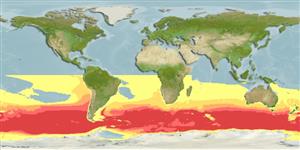Common names from other countries
Classification / Names / Names
Common names | Synonyms | Catalog of Fishes (gen., sp.) | ITIS | CoL | WoRMS
Environment: milieu / climate zone / depth range / distribution range
Ecology
Pelagic-neritic; depth range 0 - 8000 m (Ref. 1394), usually 1000 - 5000 m. Polar; 0°N - 90°S, 180°W - 180°E
Indo-Pacific, Atlantic Ocean and the Antarctic: Circumpolar in the Southern Hemisphere, Skeleton coast of Namibia around the Cape to Ilha Bazaruto in Mozambique. Polar, temperate.
Length at first maturity / Size / Weight / Age
Maturity: Lm ? range ? - ? cm Max length : 685 cm TL male/unsexed; (Ref. 99323); 300 cm TL (female); max. published weight: 5.0 t (Ref. 99323); max. published weight: 5.0 t
Prefers sandy and cobble beaches, but will haul out on ice, snow or rocky terrace); they venture inland into tussock grass and other vegetation, and frequently lie in mud wallows. Feeds on 75% cephalopods and 25% fish. Maximum measurements for female species based from Ref. 1394. Reported from 0 m- m (Ref. 1394) but is observed to occur at greater depths based on more recent data (Kaschner, K. pers. comm., 20/10/14).
Jefferson, T.A., S. Leatherwood and M.A. Webber. 1993. (Ref. 1394)
IUCN Red List Status (Ref. 130435: Version 2024-1)
CITES status (Ref. 108899)
Not Evaluated
Human uses
Fisheries: commercial
FAO - Fisheries: species profile | FishSource | Sea Around Us
Tools
Internet sources
Estimates based on models
Preferred temperature
(Ref.
115969): 0.1 - 1.6, mean 0.8 (based on 16947 cells).
Vulnerability
High to very high vulnerability (75 of 100).
Price category
Unknown.
